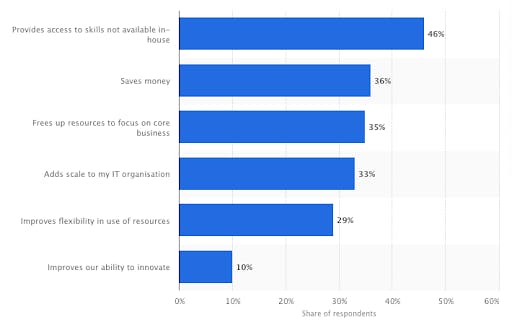
Single-Vendor and Multi-Vendor: Meaning and Comparison
We live in an unpredictable world, but the one thing is clear: the future belongs to outsourcing. These pre-pandemic yet still relevant statistics demonstrate the possibilities outsourcing brings.

According to a more recent report (2020), cost reduction, organization transformation, and enabling agile practices are the main goals of vendor outsourcing. Today outsourcing is more than just a B2B tactic.
Outsourcing as a concept is changing from make it run to make change happen
In other words, outsourcing is crucial for business growth. But what type of outsourcing can benefit your company the most? The decision is usually between options:
- Partnering up with one provider and relying on one provider with all the project stages.
- Distributing tasks to diverse vendors and finding a niche expert for each process.
In this article, we will analyze the benefits and drawbacks of single vendor vs multiple vendor outsourcing.
Single-Vendor Outsourcing
Let’s begin with what seems easier: single-vendor contractor. The single vendor meaning lies in uncomplicated cooperation between two parties — buyer and seller. The model’s name is self-explanatory, so, without further ado, we are diving into the benefits and drawbacks of single-vendor outsourcing for your company.
Pros
- Project management and coordination. The first characteristic that seems the most appealing to business owners is streamlining all the communication with one vendor. Indeed, when your trust is invested in one provider, you do not have to involve additional resources to manage project stages and elements. You can just sit back and relax.
- Compatibility. While the industry is focused on making every product more compatible, this goal is not achievable yet. According to the IDC report, systems that are not flexible enough can lead to significant financial loss. Undoubtedly, trusting all the product components to one vendor ensures an almost perfect level of compatibility.
- Pricing. If cost-reduction is an ultimate goal for your company, single outsourcing may be the solution. Price can be lowered in multiple ways: better compliance, more optimized workflow, smaller budget on project management. Moreover, it is easier to negotiate a more cost-efficient budget.
- Time. Given that you do not need to look for a variety of specialists, distribute tasks and organize cooperation, a single provider is definitely the most time-efficient solution.
The smart approach to time, money, and human resources creates a beautiful picture. Why would anyone ever consider other options besides single vendor outsourcing? But before jumping to a conclusion, we suggest you familiarize yourself with the drawbacks of single-vendor outsourcing.
Cons
- Finding the best fit. When you are developing a niche product, finding one perfect agency might be strenuous. Often all-inclusive agencies cannot deliver overly complex projects or offer profound domain expertise.
- Dependence risk. If anything happens to a company, you need to reorganize the whole project and, basically, start from scratch. While many B2B companies root for single agency outsourcing, we all must think about risk management strategies in the long run.
Multi-Vendor Outsourcing
Now, when you are well-versed on the strong and weak sides of single outsourcing. Let’s analyze in which ways multi outsourcing can be gainable for your company. It is self-evident, multi-vendor meaning denotes project management option that engages with several suppliers to complete a product. In which way is this model better compared to the one we already discussed?
Pros
- Niche expertise. The great advantage that a single vendor cannot top is niche expertise and specialized solutions. Only by going multi-vendor, you have the capability of getting the best services on the market.
- Distributing risks. One might think that a bigger company, which you choose as a single vendor, is more secure in the long run — it is less likely to run out of business. While big sole vendor companies are more reliable in some cases, the pandemic demonstrated that no one is protected from unexpected risks. By distributing tasks between several agencies, you are managing risks. With a multi-vendor outsourcing approach, you are securing yourself: you need to replace one cog rather than the whole machine if anything happens.
Cons
- Management. Working with several providers will require more human resources, extra expenses on project management. Moreover, more resources have to be geared towards QA and ensuring compatibility.
- Cost. The biggest drawback of multi-agency outsourcing is budget. You have to spend more time on budget negotiations. Also, there is no chance that distributing projects between multiple agencies will be ever cheaper than trusting one agency.
- Compatibility. Integration and compatibility is a major headache for software companies. Unfortunately, compatibility issues always accompany the distribution of processes between multiple vendors.
The Most Important Distinction between Single-Vendor and Multi-Vendor
Now you have acquired profound expertise in choosing a single vendor vs multi-vendor strategy. What’s next? To cement the understanding of types of outsourcing, let’s summarise.
Many companies choose a sole vendor outsourcing option for its time and cost-efficient results — no one can argue that time, cost, and HR are a win for sole vendor choice. Multiple-vendor outsourcing undoubtedly wins the battle in a higher quality of niche services and the ability to improve risk mitigation.
These are some undeniable conclusions on single vendor vs multiple vendor types. However, there is a grey area on this subject: time. Yes, we have already counted time as a win for the single agency. Yet, it is crucial to mention that the picture differs if your company has a higher production budget. Launching multiple processes with different vendors simultaneously can significantly reduce production time.
Quick Guide: What is my option?
Here is a comprehensive guide based on which way you should go based on your company’s priorities.
- Complex project? Multi vendors
- Long-term commitment? Single vendor
- Niche industry? Multi vendors
- Risk Management? Multi vendors
- Compatibility? Single vendor
No matter what your vendor strategy choice is, we would like to conclude with a quote by management consultant Peter Drucker, “Do what you do best and outsource the rest.”
Conclusion: What is the Right Choice for you?
We tried our best to offer an unbiased, deep analysis. To wrap up, it is vital to mention that despite some drawbacks of multiple-vendor outsourcing, the industry is moving in a multi-direction. As of 2020, the Deloitte survey reported that businesses favor an adjustable sourcing strategy with multiple interchangeable vendors.
We hope to offer you an analytical and helpful illumination of the subject. If you still have some questions, we are here for you. We at Dataxdev are always in the ready-to-code mode. We offer a vast array of services: JAVA, .NET, iOS, Android development. We are proud of our Leading B2B Service provider experience and our contribution to innovative projects in diverse industries: from healthcare to vacation rentals.
Our customer-tailored approach can satisfy any need of your business.
You may also like these posts
Get in touch!
You have an idea. We make it happen. Web and mobile app development for your business.

